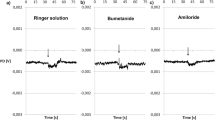Abstract
Purpose. The objectives of this study were to investigate the impedance properties of human skin in vivo and to examine the effect of iontophoresis upon them.
Methods. Having established the intra- and inter-individual variation in basal values of skin impedance, the effect of varying iontophoretic current density, ionic strength and counter-ion on the rate of recovery of skin impedance after iontophoresis was investigated.
Results. Passage of an iontophoretic current caused a significant reduction in the magnitude of the skin impedance. Increasing the current density caused an even greater reduction in the value of the skin impedance and slowed the rate of recovery. Reduction of the ionic strength resulted in an increase in the rate of recovery following iontophoresis. A significant increase in the rate of recovery was observed when CaCl2 replaced NaCl as the electrolyte. Although visual inspection revealed the presence of greater erythema when CaCl2 was used, there was an absence of the mild sensation experienced by volunteers when using NaCl. The last part of the study established a correlation between transepidermal water loss and impedance analysis as complementary methods for probing skin barrier function in vivo. The data were fitted to an equivalent circuit consisting of a resistor in parallel with a constant-phase element and a mechanistic model proposed to explain the electrical properties of the skin.
Conclusions. The first comprehensive investigation of the effect of iontophoresis on the electrical properties of human skin in vivo has been described. It would appear from the results, and from their interpretation, that impedance spectroscopy may be an effective method to quantify the impact of iontophoresis on the skin, and to determine the extent to which proposed drug delivery regimens will perturb skin barrier function.
Similar content being viewed by others
REFERENCES
P. M. Elias, Epidermal barrier: intracellular lamellar lipid structures, origin, composition and metabolism, J. Control. Release, 15: 199–208 (1991).
C. Cullander and R. H. Guy. Transdermal delivery of peptides and proteins. Adv. Drug Delivery Rev., 8: 291–324 (1992).
T. Yamamoto and Y. Yamamoto. Electrical properties of the epidermal stratum corneum. Med Biol. Eng. 14: 151–158 (1976).
K. Kontturi, L. Murtomäki, J. Hirvonen, P. Paronen and A. Urtti. Electrochemical characterization of human skin by impedance spectroscopy: the effect of penetration enhancers. Pharm. Res. 10: 381–385 (1993).
K. Kontturi and L. Murtomäki. Impedance spectroscopy of human skin. A refined model. Pharm. Res., 11: 1355–1357 (1994).
H. Inada, A. H. Ghanem and W. I. Higuchi. Studies on the effects of applied voltage and duration on human epidermal membrane alteration/recovery and the resultant effects upon iontophoresis. Pharm. Res., 11: 687–697 (1994).
R. R. Burnette. Iontophoresis. In J. Hadgraft and R. H. Guy (eds.), Drugs and the pharmaceutical sciences (Vol. 35): Transdermal drug delivery, Marcel Dekker Inc., New York, 1989, 247–291.
J. Z. Bao, C. C. Davis and R. Schmukler. Impedance spectroscopy of human erythrocytes: system calibration and nonlinear modeling. IEEE Trans. Biomed. Eng., 40: 364–378, (1992).
J. R. Macdonald. Impedance spectroscopy. Ann. Biomed. Eng., 20: 289–305 (1992).
J. R. Macdonald. Complex nonlinear least squares immitance fitting program-LEVM version 6.1, © Solartron Instruments Ltd., distributed by Scribner Associates, Charlottesville, VA (1994).
J. C. Keister and G. B. Kasting. A kinetic model for ion transport across skin. J. Membr. Sci., 71: 257–271 (1992).
R. R. Burnette and B. Ongpipattanakul. Characterization of the pore transport properties and tissue alteration of excised human skin during iontophoresis. J. Pharm. Sci., 77: 132–137 (1988).
C. Cullander and R. H. Guy. Sites of iontophoretic current flow into the skin: identification and characterization with the vibrating probe electrode. J. Invest. Dermatol., 97: 55–64 (1991).
J. J. B. Jack, D. Noble and R. W. Tsien. Electric current flow in excitable cells. Oxford University Press, Oxford, (1975).
Author information
Authors and Affiliations
Rights and permissions
About this article
Cite this article
Kalia, Y.N., Guy, R.H. The Electrical Characteristics of Human Skin in Vivo . Pharm Res 12, 1605–1613 (1995). https://doi.org/10.1023/A:1016228730522
Issue Date:
DOI: https://doi.org/10.1023/A:1016228730522




